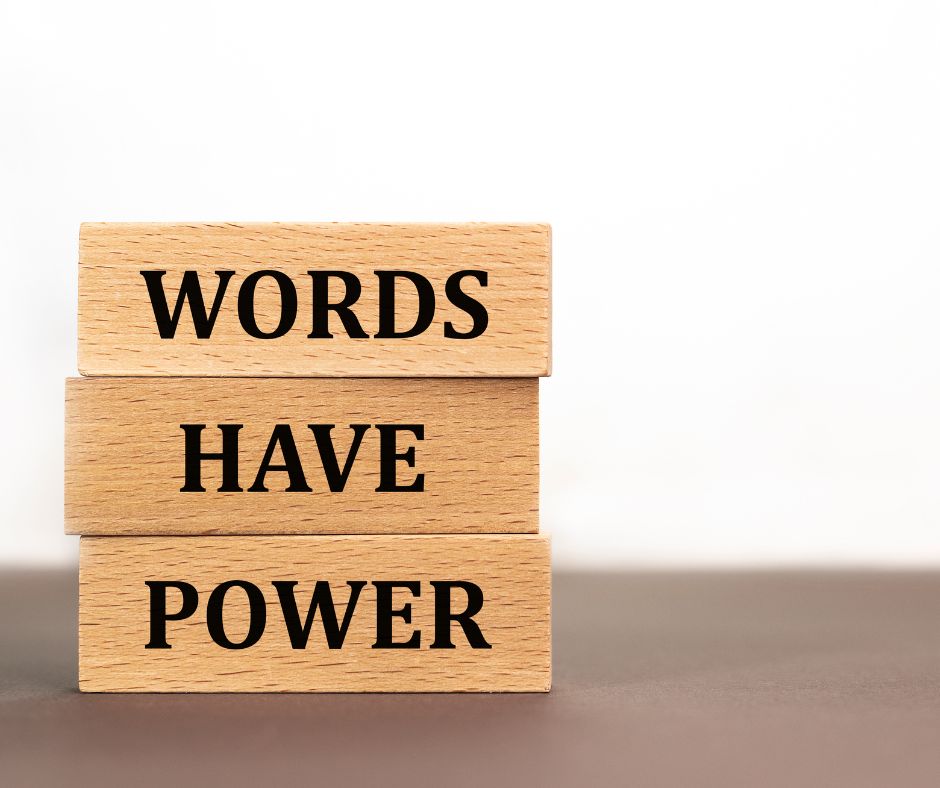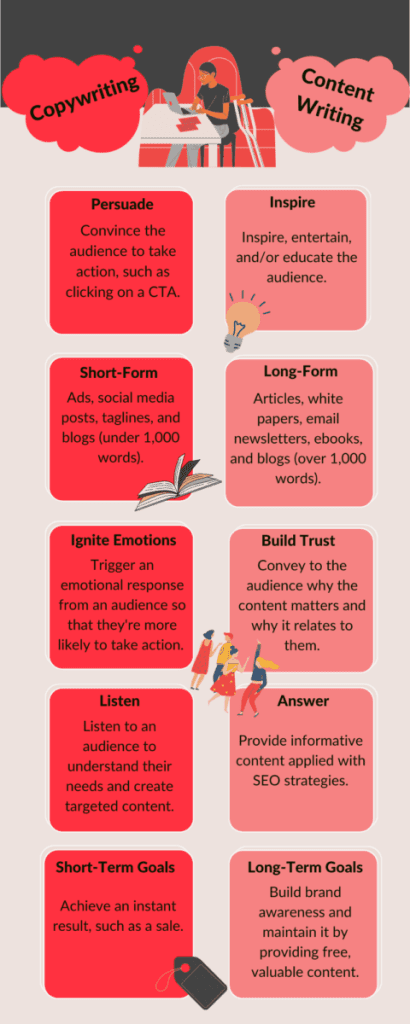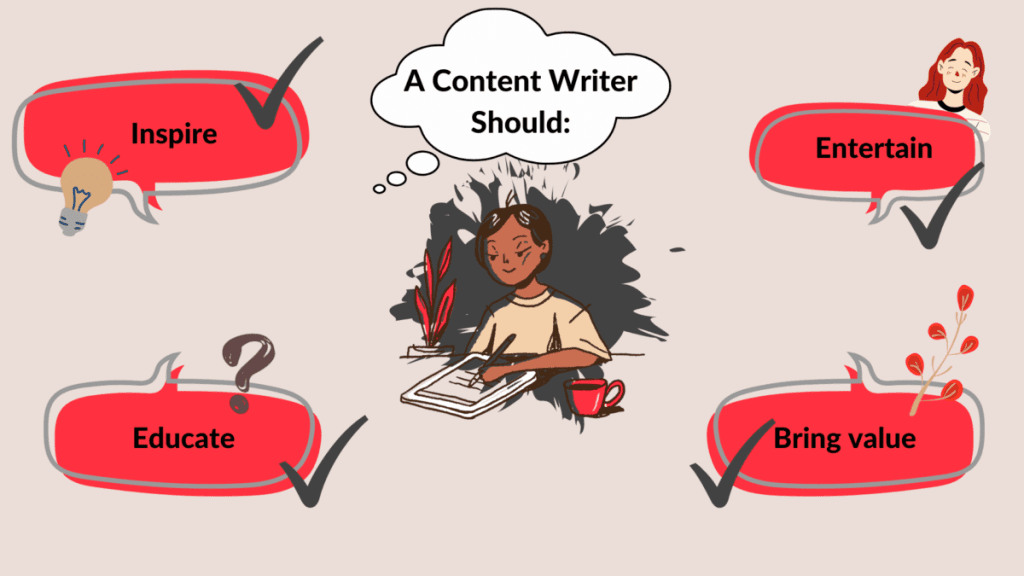Copywriting vs Content Writing: What’s The Difference?

What is copywriting? And how does it differ from content writing?
Well, to put it simply, their purposes are different.
Copywriting is the art of creating content that “sells” a product or service to its reader. It is a quick and effective way to help increase brand awareness. It’s similar to a call-to-action (CTA), but on a slightly bigger scale. A copywriter’s main goal is to persuade.
Content writing falls under the same umbrella as copywriting, but it’s a longer form of writing that’s more subtle in its marketing approach. It is an effective way of maintaining brand awareness. A content writer’s main job is to tell a story that inspires, entertains, and/or educates.
Both copywriters and content writers are necessary for brands that want a well-rounded marketing strategy to target audiences at every point in their customer journey.
To help you better understand the differences between copywriting and content writing, I’ve put together a list of key elements that each has, along with 5 tips to help you effectively hone your skills, whether that be as a copywriter or content writer.

1. Persuading vs Inspiring
Persuading
A copywriter’s job is to persuade their readers. They aim to convince readers to take action, such as signing up for a newsletter, buying a product/service, or simply clicking on a CTA.
The best copywriters are concise, which enables them to deliver a clear message to their readers. They maintain brevity in their writing by cutting out unnecessary words.
For example, too many adverbs and adjectives can be distracting to readers. Additionally, throwing in too many descriptive words could be considered too pushy. The idea is to persuade rather than try to force your readers into action by overwriting.
A quick, snappy piece of copy is ideal for grabbing the attention of people who may not have heard of the brand before. The copy is designed to “sell” a product or service that can solve a problem for the reader. Once hooked, the new customer is maintained – nurtured – through valuable content.
Copywriting Tip: Cut out unnecessary words. Be frugal when using adverbs and adjectives.
Inspiring
A content writer’s job is to provide useful information that can inspire, entertain, and/or educate readers. This doesn’t mean that their long-term goal isn’t to persuade readers to take action, such as purchasing a product/service; it may well be that this is the desired result, but their approach is subtle, and the content that is delivered provides something of value to the reader.
For example, consider a yoga school that is wishing to recruit more students for their classes. Instead of writing short copy that specifically directs readers to a CTA, such as a ‘Book Now’ button – although this would be perfectly okay to do, too – they could write longer, valuable content, such as a blog post on the benefits of practising yoga. This is free content, which a reader would find useful and inspiring. The good thing is that you could still stick a CTA at the end of the blog post, encouraging readers to ‘Book Now’.
Valuable content helps to build trust in existing customers or to gain trust from prospective ones. If done well, the brand can be strengthened through the content they deliver as it demonstrates that the business is knowledgeable in its field.
Content Writing Tip: As with copywriting, use adverbs and adjectives sparingly. It can be tempting to be more descriptive when writing longer pieces of content; however, remember that readers can easily lose focus. To refrain from wandering off topic, continually remind yourself of the purpose of the piece.

2. Short-Form vs Long-Form
Short-Form
Copywriters tend to write more short-form pieces.
Examples of short-form writing include ads, social media posts, taglines, and (depending on the length) blog posts.
Content that is around 1,000 words and under is considered short-form writing.
Copywriting Tip: Be clear about what problem the product or service is solving.
Long-Form
Content writers create long-form content.
Examples of long-form writing include blogs, articles, white papers, email newsletters, and ebooks.
Content that is above 1,000 words is considered long-form writing.
Content Writing Tip: Consider the dual readership path. You should try to write for a true reader as well as for a reader that skims. Break up the content with subheadings and bullet points.
3. Igniting Emotions vs Building Trust
Igniting Emotions
Good copy should ignite emotion in the reader.
For example, if an ad evokes an emotional response, such as desire or fear, then the reader is much more likely to take action – they’re much more likely to click the CTA.
Certain words and phrases are deliberately used in short-form writing with the sole purpose of triggering an emotion.
For example, ‘deadline’ or ‘act now’ are used to ignite fear – FOMO (fear of missing out) – and a general feeling of urgency.
Consider the modes of persuasion below:
Ethos – Establishes credibility. Aims to convince the reader of a brand’s trustworthiness.
Pathos – Appeals to the reader’s emotions, such as joy or envy.
Logos – Appeals to the reader’s logical side through facts and figures.
Kairos – Appeals to the reader’s sense of time, such as creating a sense of urgency.
While emotive words and phrases are catchy and can help in persuading an audience to purchase a product/service, copywriters should try to avoid using jargon or idioms within their content. In addition to being overused, these words/phrases could make the content appear unoriginal.
Copywriting Tip: Avoid overused jargon. Be unique and compelling. Connect with your reader on an emotional level, but be honest. Be bold and unexpected, but don’t “shock” your audience into reading something only for them to find out you were being disingenuous.
Building Trust
Long-form content is designed to help build trust.
Good content writers should be able to convey to the reader why the content matters. Then, more importantly, how it directly relates to the reader. It should inspire readers to continue reading.
Valuable content is useful to a reader because of either its educational, inspirational, or entertaining aspects. However, the benefits may not be immediately apparent to a reader. So, for them to relate to the content, first, they need to be able to recognise the problem the content is fixing; they need to be able to see where or how their life can be improved. This is where long-form content can help. Over time, content writers can develop a reader’s trust in a brand.
By offering consistent and knowledgeable content, which can offer a “fix” for a problem, a wider audience will be able to relate to the brand at different stages in their customer journey.
Additionally, with more useful content behind them, a brand can be seen as more genuine, and be considered a thought leader in its field.
Content Writing Tip: Provide original content. Avoid simply copying and pasting existing content from other sources. Think of your own experiences as well as conduct thorough research.
4. Listening vs Answering
Listening
Good copywriters are only able to create effective copy after they’ve researched and “listened” to their audience.
Ads and social media posts are supposed to give the audience what they’ve been asking for. It’s about solving a problem that the audience has. Copywriters can only discover these problems by looking at what their competitors are doing, and through “listening” on various platforms, such as social media.
Copywriting Tip: Be clear, but conversational. Use the language of your audience. Imagine the person you are talking to since this can help your writing appear more “real”.
Answering
Long-form content can help to answer readers’ questions. This is where a good knowledge of SEO (search engine optimisation) and, more specifically, keyword research, can make a difference.
Both short-form and long-form writing should be optimised with the reader in mind. For example, both should include relevant keywords or phrases that readers are most likely to type into a search engine when looking for an answer to a question, or a solution to a particular problem.
Long-form content provides more opportunities for writers to apply more SEO strategies since content writers can delve deeper into a topic which means that they can cover a wider range of keywords.
Content Writing Tip: Create your content with relevant keywords in mind. (Include the main keyword in the title, header, subheaders, and in the main text body). However, do ensure that the overall content isn’t negatively affected. Sentences should be optimised for readers, not search engines; the content should make sense and be conversational.
5. Short-Term Goal vs A Long-Term Strategy
Short-Term
The goal of most copywriters when creating short-form content is to achieve an instant result.
For example, some content may be specifically designed to persuade readers to ‘Order Now’. This sales-driven form of content can help businesses to achieve their short-term goals, such as improving their sales.
However, this type of marketing, via ads and taglines, cannot help to maintain an audience. Most people need substance to back up a brand. For example, an active online presence, through blogs and social media posts, etc, can help an audience establish trust in a brand.
Copywriting Tip: Even if your message is short, be consistent with it. Ensure that the voice of the brand is clear and unique and that it remains consistent over different platforms and marketing campaigns.
Long-Term
Long-form content is created in the hope that it will maintain a reader’s interest in the brand. It helps to keep the brand at the forefront of people’s mind without being too much like a sales pitch.
For example, valuable content in the form of a blog post can easily link back to a brand’s website in a non-invasive way. Readers may decide to click on the website link, not because they have been persuaded to take instant action, but because they’ve been inspired, and are interested in finding out more. This helps to lay the groundwork needed to build new and long-lasting customers.
Long-form content makes up a big part of a long-term marketing strategy. The more valuable content a brand has, then the more evergreen content they accumulate.
Evergreen content is search optimised content that stays relevant for longer, or that can easily be adapted and reused.
Content Writing Tip: Inject value into every sentence. Avoid repetition. If you’ve written a sentence that is just a slightly reworded version of a previous sentence, then delete it. Again, the aim is not to distract your reader from the message you’re trying to deliver.
I hope that you’ve found this blog informative and that these writing tips will be useful for when you next write content, whether that be short-form or long-form.
Contact Us
Cheshire (Head Office)
Manchester
Get in touch
Let’s find the best solution for your business
